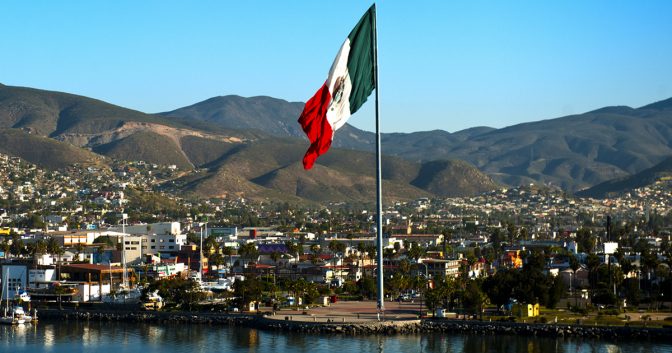Freedom Leaf Travel: Welcome to Baja California

It’s just 17 miles from San Diego to where Mexico begins and two hours from Long Beach, where I used to live. Last year, I moved to Ensenada in Baja California, which is on the Pacific Ocean about two hours (70 miles) south of the border.
Spanning 745 miles north to south, the Baja peninsula is one of the world’s longest. Halfway down it becomes another state, Baja California Sur, and at the southern tip is the tourist destination Cabo San Lucas.
Before the move, I was bombarded with inaccurate information from well-meaning friends about what to expect. The biggest misconception is that Mexico is dangerous. Yes, five of the country’s 32 states have Level 4 “Do Not Travel” warnings, “due to violent crime and gang activity,” according to the U.S. State Department. But Baja is listed as a Level 2, meaning “Exercise Increased Caution.” The state’s main tourist hubs— Ensenada, Rosarito and Tijuana—are considered safe (see “Baja California Travel Advisory” below).

It’s just 17 miles from San Diego to the Mexico border, and another 70 to Ensenada.
Americans are easily frightened by sensationalistic media accounts of mass executions and cartel violence. But like the violent crime that occurs in the U.S. every day, these activities rarely affect the average citizen or tourist.
Clearly, there are parts of Mexico that should be avoided. But statistically speaking, my new adopted city has far less crime, from petty theft to homicides, than Long Beach. Local expats laugh at the dire danger warnings delivered by people who’ve never been here. If anything, they help keep the wave of Americans migrating south of the border somewhat in check.
Quiere Mota?
The second misconception uninformed Americans like to spread is how terrible the marijuana or mota is in Mexico. For people who grew up in the ’60s and ’70s, Mexican-grown pot was the first they ever smoked. It worked then, but now it’s considered low-end schwag.
Tightly compacted, seed-studded Mexican brickweed still exists. But some Mexican growers have upped their games, and it’s not too hard to find nicely cured, midrange-quality buds for $50-$100 an ounce. They’re potent, but not necessarily the best tasting or most smooth on the throat.
True connoisseurs should have little trouble finding U.S. grown, dispensary-quality cannabis; a fair amount finds its way south to service the American expat communities. While locally grown mota is a bargain, expect to pay American dispensary prices for weed that’s crossed the border.
Drug-Policy Reform in Mexico
The final misconception is that Mexico has legalized medical marijuana and will likely legalize adult use soon. In actuality, last June, Mexico legalized “pharmacological derivatives of cannabis” to be regulated and studied by the Ministry of Health. Those products must contain less than 1% THC. Actual plant matter is not allowed.
Three-quarters of the citizens in this heavily Catholic country support medical marijuana, but as far as recreational use, Mexico still has a long way to go. A 2015 poll showed 73% of Mexicans oppose legalizing marijuana, but also that year, the Supreme Court ruled in favor of home growing, though that has yet to legally happen. Possession of small amounts of various drugs for personal use was decriminalized in 2009; for marijuana, that’s less than five grams.
Still, cannabis remains deeply ingrained in the public consciousness as a catalyst for the drug-cartel violence that’s devastated the country for decades. Mexico had 25,340 homicides in 2017, while the U.S., with more than twice as many people, had 17,250 in 2016. The fact that the cartels have drastically reduced their cannabis production due to competition from U.S.-grown pot, however, seems lost on casual observers.
Popular former President Vicente Fox, in office from 2000-2006, is one of Mexico’s most vocal supporters of ending the drug war and legalizing cannabis. But in an interview with Bill Maher on Feb. 16 on HBO’s Real Time, he acknowledged that not much is likely to happen in that regard, especially not before the July 1 presidential election.

Mexican presidential candidate Andrés Manuel López Obrador
Legalization could be fast-tracked if Andrés Manuel López Obrador becomes Mexico’s next president. The leader of the leftist National Regeneration Movement party has vowed to end the drug war in Mexico within the first three years of his presidency. One of his more controversial plans is to offer the cartels amnesty in exchange for peace. López Obrador is currently ahead in the polls by 14%.
Another recent vocal proponent of legalizing cannabis is Tourism Secretary Enrique de la Madrid, who thinks marijuana should be available in tourist resorts in order to reduce drug war violence there. He suggested starting in Cancun and Cabo San Lucas, both popular tourist destinations that have recently seen spikes in gang violence. “It’s absurd that we’re not taking this step as a country,” he stated.
Mexico depends on tourism dollars, and violence in these areas generates negative international headlines. Whether De La Madrid’s theory of selectively legalizing marijuana would curb cartel violence is highly debatable, but it could provide a path towards national legalization.
South of the Border to Ensenada
Three-quarters of Baja’s people live in the state capital of Mexicali, the sprawling border city of Tijuana or the port of Ensenada. Most tourists arrive at the latter on enormous cruise ships.
There’s plenty to do in Ensenada for those operating on the tight time constraints of a cruise-ship schedule. Beyond the rows of stalls hawking cheap souvenirs and past the giant gold heads of Mexican heroes Benito Juarez, Miguel Hidalgo and Venustiano Carranza, you’ll find a bustling city with shops and restaurants that appeal to locals and visitors alike.
Famous watering holes like Hussong’s Cantina at Av. Ruiz 113 fulfill obligatory margarita-consumption requirements. Visit the Museo de Historia de Ensenada at Boulevard Costero 2. Depending on when boats dock, the waterfront may be in the midst of one of its many food, wine, music, arts or holiday festivals.

One of the many fresh seafood stands in Ensenada.
Celebrity chefs Anthony Bourdain, Eric Ripert and Rick Bayless have raved about Ensenada’s cuisine. The La Guerrerense street cart at Av Adolph López Mateos 917 is a favorite; it offers a dazzling array of fresh shrimp, oysters, clams, abalone and octopus, served in various combinations as ceviche tostadas or in Mexican-style seafood cocktails. Seafood carts in Ensenada are common as coffee shops in Seattle.
Those crossing over into Mexico by car at San Ysidro, just south of San Diego, should bypass the bustle of Tijuana and take the well-maintained toll road about two hours to Ensenada, enjoying breathtaking coastal views that rival those of Northern California.
A city of more than half a million residents, Ensenada offers leisure activities for everyone’s taste, including fishing, kayaking, golfing, hiking, surfing, whale watching, natural hot springs, exciting nightlife and relaxing white-sand beaches—all at about half the cost or less of similar travel in the States.
About an hour northeast of Ensenada is the Valle de Guadalupe wine country. Take a leisurely tour along the picturesque Ruta del Vino and taste wines that have been racking up international medals. The area is also known for its innovative chefs and restaurants—several (Corazón de Tierra and Laja) are among the best in Latin America.

Vineyard in Baja California’s Valle de Guadalupe, near the town of El Porvenir
With the political rhetoric about Mexico emanating from the White House so toxic these days, you might expect locals to be hostile towards Americans. For the most part, they’re warm and welcoming. In tourist areas, this might be attributed solely to economic self-interest, but in the surrounding towns and villages strong mutually beneficial community bonds that transcend politics thrive between Mexican citizens and expats. The groups work together to raise money for schools, seniors and orphanages, build homes for the poor, clean up the beaches and rescue unwanted animals.
It’s all surprisingly harmonious, especially contrasted with the immigration debate in the States. One last suggestion for U.S. visitors: Just don’t mention the wall.
Baja California Travel Advisory
The latest State Department travel advisories for Mexico, published in January, recommended “Do Not Travel” to five of Mexico’s 32 states (Colima, Guerrero, Michoacan, Sinaloa and Tamaulipas) and “Reconsider Travel” to another 11. Baja California is listed as Level 2 (“Exercise Increased Caution”). The warning for Baja reads:
“Criminal activity and violence, including homicide, remain an issue throughout the state… The state experienced an increase in homicide rates compared to the same period in 2016. While most of these homicides appeared to be targeted criminal organization assassinations, turf battles between criminal groups have resulted in violent crime in areas frequented by U.S. citizens. Bystanders have been injured or killed in shooting incidents.
“Due to poor cellular service and hazardous road conditions, U.S. government employees are only allowed to travel on La Rumorosa between Mexicali and Tijuana on the toll road during the day. There are no U.S. government restrictions in tourist areas, which include Ensenada, Rosarito and Tijuana.”
Related Articles
Freedom Recipes: Mexican-Fusion Cuisine, Baja Med-Style
A Brief History of Marihuana in Mexico
Vicente Fox’s Global Vision: Legalization of All Drugs
A $57 Billion Worldwide Cannabis Market by 2027?
Cannabis Law Reform Developments Around the World

